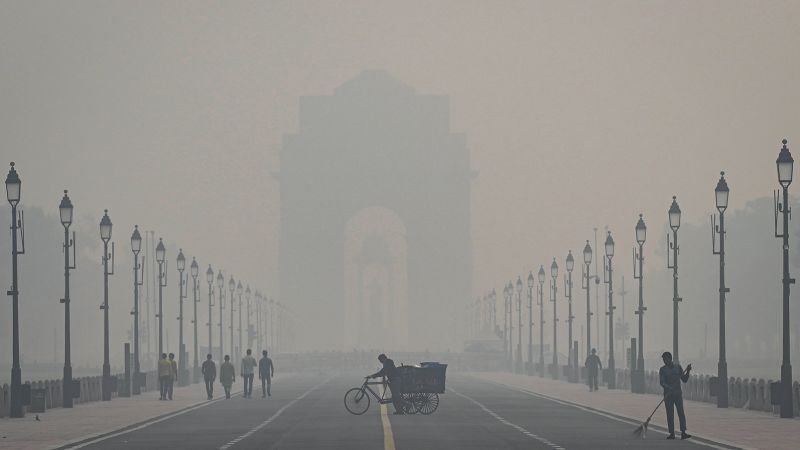More than 20 million people woke last week to a thick, acrid, and noxious smog that settled densely across the Indian capital.
That’s clearly not invisible.
Tbh it’s not clearly anything, it’s not clear at all. In fact it’s pretty opaque.
Gotta love the ironic use of ‘clearly’. Nice.
Having four times the population density (
5900 people per square km vs 1300numbers are chosen poorly, see exchange with zershuffle in the replies) and way less money to throw at the problem can’t help. Not to say that it’s hopeless or that India shouldn’t try to clean up its air, of course, but the problem at a glance definitely looks tougher to solve for New Delhi than for BeijingA huge amount of the pollution comes from farmers burning stubble. The solution to that isn’t complex.
Comparing New Delhi (an area of 43km2) to the Beijing metropolitan area (16400km2)… Nice.
That was actually a mistake on my part, thank you for catching that. It looks like the National Capital Territory of Delhi with a population of 16.8 million would be the better comparison? And that has an even higher density
It’s a different definition of metropolitan area, I think. A lot of Beijing’s area is extremely sparsely populated, moreso than Delhi’s.
They should’ve used another picture of Beijing from the same perspective to demonstrate the difference in smog. Honestly… that picture of the building looks smoggy to me.
This is the best summary I could come up with:
Primary schools were forced to shut, vehicles restricted from traveling on roads and construction brought to a halt as a hazy gray enveloped New Delhi, blocking buildings from view and prompting residents to panic buy air purifiers.
New Delhi’s current toxic skies are reminiscent of another major Asian capital that about a decade ago was famous for a smog so thick that it could shroud entire skyscrapers from view: Beijing.
What followed was a rollout of new regulations, including restricting the number of vehicles on the roads in major cities, tightening environmental oversight and controls on emissions, building a nationwide system of air monitoring stations, and reining in coal and other heavy-polluting industries.
Traditionally, toward the end of the year after the winter harvest, millions of farmers clear their leftover rice stubble by setting fields alight to prepare for the incoming wheat crop.
At a nationwide level, India launched its Clean Air Programme in 2019, ushering in strategies across 24 states and union territories to reduce particulate matter concentration by 40% by 2025-26.
To tackle the problem the city this year plans to induce rain to wash away the dust – a method adopted by other Asian countries, including China, Indonesia and Malaysia.
The original article contains 1,565 words, the summary contains 192 words. Saved 88%. I’m a bot and I’m open source!
You see, a history of lying helps.
As far as I understamd they just moved the factories and cole power plants further away from Bejing.
So the smoke isn’t where most people live? Seems like a good idea.
Yes it is until you realize that the smoke/pollution can go jut about anywhere: water, soil, rain, food sources etc.
It is like idk moving a problem some where else it isn’t actualy solving that problem. smh
If the problem is “large number of citizens are negatively effected by excessive smog levels”, it does fix the problem.
One problem at a time.
Emissions standards were enforced on coal power plants, cars were tightly regulated, and home energy was pushed towards gas (which burns with less particulate emissions) or electricity.
Capitalism
Catalytic converters and basically all modern industrial post processing of byproduct are expensive in the eyes of any 3rd world country.
Pakistan has the same issues right next door.
Pakistan won’t do it until bribe money can be invovled in it. India won’t do it until it’s practically free.
Doesn’t excuse them from not trying at all, but it is unlikely nothing besides maybe some traffic limiters will ever be implemented.
Because corporate profit means more than people. Now that China isn’t ‘the economy the world is based on’ - their production is down AND their pollution is down.
China is a dictatorship, the government decides to do something, no choice but to do it.
India is a democracy, government’s got to convince everyone, including the powerful and moneyed that the thing they want to do is worth it.
India is a democracy, government’s got to convince everyone …
India is a federation of ~30 states, with wildly varying levels of democracy. Now this is usually a good thing; it has allowed us to accomodate a great deal of cultural and economic diversity without breaking up. But a major cause of the pollution in Delhi is stubble burning in neighbouring, which the government of Delhi has no power over. And the union (i.e. federal) government is led by a different party, so they don’t co-operate with the Delhi government.
You got no idea how India works, or how dictatorships with a “democracy” mask work, liberal virtue signaller.
Sounds like democracy doesn’t benefit the people idk
Sounds like the people have no say otherwise, idk
A democracy where people have a voice that the ruling class can choose to ignore. Hmm.
Democracy runs opposed to capitalism.
Whatever commie
Sounds like neither benefits the people.
It should’ve never been bad to begin with. That smog didn’t just magically disappear. It’s in their soil, their water, their body.
Why?
Oh, right, because they are building and growing goods being sold halfway around the world
LMFAO the only people who call China a dictatorship are racist weirdos from the west who couldn’t find China on the map. Here’s what people actually living in China have to say https://web.archive.org/web/20230511041927/https://6389062.fs1.hubspotusercontent-na1.net/hubfs/6389062/Canva images/Democracy Perception Index 2023.pdf
Don’t be ridiculous, the opinions of the citizens of other countries don’t matter! What really matters is how I, the enlightened Westerner feel about it based off of what my country’s state media tells me! Chinese people don’t know what they really want, which is a new cold war egged on by dangerous hoaxes and sinophobia!
Given the massive downvotes, it’s pretty clear this is what a lot of people here think completely unironically.
Oh yes, absolutely. Products of the most effective propaganda machine in history.
Removed by mod
So autocracies are better on environmental policy?
When you definitely know what autocratic means.
You seem to have mis-read my comment. I did not say that China was an autocracy, I said that it was more autocratic than India - there’s a huge difference.
That’s still a completely baseless assertion as I’ve explained in detail down in this thread.
https://en.m.wikipedia.org/wiki/Autocracy
Autocracy is a system of government in which absolute power is held by the ruler, known as an autocrat. It includes most forms of monarchy and dictatorship, while it is contrasted with democracy and feudalism.
That checks out.
It really doesn’t.
We’re talking about China and not the US here bud. Nice try though, keep exposing yourself as an utter clown.
Removed by mod
China is absolutely not an autocracy. Here are a few resources on how the system actually works in China, and if you think that’s an autocracy then you really have no clue what autocracy is.
- https://news.cgtn.com/event/2019/whorunschina/index.html
- https://news.cgtn.com/event/2021/who-runs-the-cpc/index.html
Here’s how elections work in China https://nitter.net/thinking_panda/status/1305784641262026752
Turns out, people actually living in China see their system as a democracy, pretty sure they have a better idea of what their system is than you do
- https://web.archive.org/web/20230511041927/https://6389062.fs1.hubspotusercontent-na1.net/hubfs/6389062/Canva images/Democracy Perception Index 2023.pdf
- https://www.bloomberg.com/opinion/articles/2020-06-26/which-nations-are-democracies-some-citizens-might-disagree
- https://web.archive.org/web/20201229132410/https://en.news-front.info/2020/06/27/studies-have-shown-that-china-is-more-democratic-than-the-united-states-russia-is-nearby-and-ukraine-is-at-the-bottom/
In fact, far more people in China see their system as being democratic than in any western nation.
A Harvard study also shows that the government has mass popular support from the public, another phenomenon we don’t see in any western nation calling itself a democracy https://ash.harvard.edu/publications/understanding-ccp-resilience-surveying-chinese-public-opinion-through-time
Maybe learn how Chinese political system actually works in China instead of just regurgitating misinformation you’ve been spoon fed by western propagandists?
Do you consider it normal that a mere dictionary citation triggers such a violent, unhinged and irrelevant response?
Do you consider it normal to spend your time doing obvious trolling? Kind of hilarious that a person who has an urge to jump into a thread to spread misinformation would talk about violent, unhinged and irrelevant response. Seems like you’re doing a bit of projecting there bud.
Who is trolling here? Who is posting uninformative comments? Mine were on topic, yours jumped on my neck with insults. It’s your right to disagree with what I have to say, though none of what you posted here has any argumentative value.
The fact that you think your comment was on topic is really the cherry on the cake here. Perhaps you really don’t realize you’re a troll.












